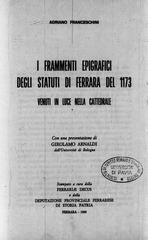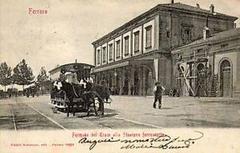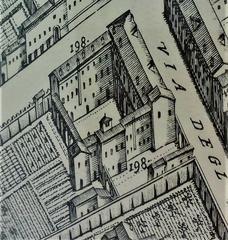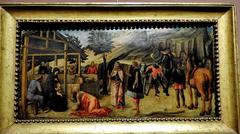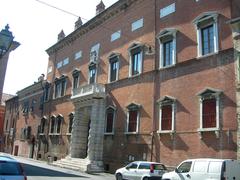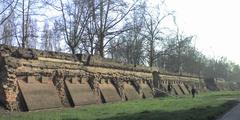
Palazzo Renata di Francia: Visiting Hours, Tickets, and Historical Highlights in Ferrara, Italy
Date: 04/07/2025
Introduction
Palazzo Renata di Francia stands as a remarkable symbol of Ferrara’s Renaissance heritage and the enduring influence of the Este family. This palatial residence, nestled within Ferrara’s UNESCO-listed historic center, exemplifies the city’s transformation during the Renaissance era into one of Europe’s earliest modern planned cities. Originally constructed in the late 15th century and expanded under the guidance of architect Biagio Rossetti, the palazzo embodies Renaissance ideals of symmetry, proportion, and the integration of indoor and outdoor spaces.
Named after Renée of France (Renata di Francia), daughter of King Louis XII of France and wife to Ercole II d’Este, the palace became a vibrant cultural hub, welcoming artists, writers, and reformers. While the interior is currently closed to regular tours due to restoration following the 2012 Emilia earthquake, the adjacent Parco Pareschi garden remains open and accessible, offering visitors a glimpse into the palazzo’s historical landscape.
This comprehensive guide details the palazzo’s origins, architectural features, cultural significance, visiting information, and its broader context within Ferrara’s Renaissance legacy. For the most current updates, check official Ferrara tourism resources. (Ducato Estense, European Waterways, Nomads Travel Guide, Ferrara Terra e Acqua)
Origins and Architectural Development
The palazzo, also known as Palazzo Pareschi or Palazzo Gavassini, was initiated by the Este family in the late 15th century as part of a broader urban expansion. Major works began in 1474, with Biagio Rossetti—Ferrara’s pioneering urban planner—soon taking charge. His vision contributed to Ferrara’s status as an early example of rational city planning. The building’s layout features a spacious quadrangular courtyard, a smaller side courtyard, and what is now Parco Pareschi, reflecting Renaissance principles of order and harmony. (Ducato Estense, European Waterways)
Este Family Patronage and Notable Residents
The Este dynasty was instrumental in shaping the palazzo’s history and Ferrara’s cultural life. Ercole I d’Este began its expansion, and Ippolito II d’Este commissioned extensive artistic decoration in the 1530s. The most renowned resident, Renée of France, established the palace as a center for intellectual and religious discourse. Her patronage and progressive views attracted artists and reformers, making the palazzo a focal point of Renaissance courtly culture. (Ducato Estense)
Artistic and Architectural Evolution
The palazzo’s original Renaissance design, attributed to Rossetti and other Este court architects, featured arcaded courtyards, elegant facades, and refined decorative details. In the 16th century, lavish frescoes and stuccoes were added. The 18th century brought Baroque and Neoclassical renovations, including a grand staircase and frescoed salons, while retaining Renaissance elements like the main courtyard and sculpted capitals. (Ducato Estense)
Historical Events and Cultural Significance
Palazzo Renata di Francia played a significant role in Ferrara’s history, especially during the Reformation. Renée of France’s support for Protestant reformers made the palace a hub for new ideas and debate. The shifting fortunes of the Este family and later uses—including as the University of Ferrara’s rectorate—underscore its ongoing civic relevance. (Ducato Estense, it.wikipedia.org)
Façade and Exterior Features
The façade embodies Renaissance restraint, constructed from local brick and organized symmetrically with a central entrance framed by stone pilasters. String courses and carefully proportioned windows create a dignified, harmonious effect. The understated elegance distinguishes it from more ornate Italian palaces, favoring intellectual refinement over ostentation.
Courtyard and Internal Layout
Entering the palazzo, visitors would find a spacious Renaissance courtyard surrounded by arcaded porticoes and paved with terracotta or stone. The layout, with rooms arranged around the courtyard, reflects Renaissance ideals of light, air, and harmonious organization. The grand staircase and piano nobile reception rooms highlight both functional and ceremonial aspects of courtly life.
Decorative Elements and Artistic Details
While much original interior decoration has faded, traces of frescoes, stuccoes, and painted ceilings remain. The main portal once bore the Este unicorn emblem, and 15th-century capitals and grotesque animal motifs survive. Artistic embellishments were created by court artists such as Gabriele Frisoni da Mantova and Giovanni Trullo, reflecting the Este court’s cultural sophistication.
Structural Innovations and Renaissance Ideals
The building’s design demonstrates Renaissance advances in symmetry and classical proportions. The central courtyard, axial alignments, and integration with gardens show the influence of Leon Battista Alberti and the era’s embrace of rational planning and humanist values.
Preservation and Restoration
Over centuries, the palazzo has undergone restoration to preserve both its Renaissance and later Baroque elements. Modern conservation prioritizes traditional materials and reversible techniques. The 2012 earthquake prompted ongoing restoration, and as of July 2025, the interiors remain closed. (Tripazy)
Visiting Information: Hours, Tickets, Accessibility
- Current Status: Due to restoration following earthquake damage, the palazzo’s interior is currently closed to the public. Parco Pareschi remains open daily from dawn to dusk.
- Tickets: Prior to closure, entry was free during university hours. Future ticketing will be announced upon reopening.
- Accessibility: The garden and exterior are wheelchair accessible; some interior areas may remain limited due to the building’s age. (prolocosantagostino.it)
- Guided Tours: Tours and cultural events are offered occasionally, depending on restoration progress and university scheduling.
- Travel Tips: The palazzo is centrally located near Castello Estense, Palazzo dei Diamanti, and other major attractions. Confirm visiting status and hours before your visit.
For the latest updates:
Nearby Attractions
- Castello Estense: Ferrara’s imposing moated castle.
- Palazzo dei Diamanti: Renowned for its diamond-pointed façade and art exhibitions.
- Palazzo Schifanoia: Famous for Renaissance frescoes.
- Ferrara Cathedral: A masterpiece of Romanesque-Gothic architecture.
- Palazzo Paradiso: Home to the Ariostea Library.
These sites are all within walking or cycling distance, making Ferrara’s historic center accessible and enjoyable.
Cultural Significance and Legacy
Palazzo Renata di Francia encapsulates Ferrara’s Renaissance cosmopolitanism and intellectual openness. Renée of France’s residence attracted artistic and religious innovators, and the palazzo’s later uses reflect its enduring civic role. Ongoing restoration ensures its preservation as part of Ferrara’s UNESCO World Heritage site. (UNESCO Ferrara)
Frequently Asked Questions (FAQ)
Q: Is Palazzo Renata di Francia currently open to visitors?
A: As of July 2025, the palazzo’s interior is closed for restoration. The Parco Pareschi garden is open.
Q: Are tickets required?
A: There is no charge to visit the garden; future ticket policies for the interior will be announced upon reopening.
Q: Is the site accessible for wheelchair users?
A: The garden and exterior are wheelchair accessible. Interior accessibility may be limited.
Q: Are guided tours available?
A: Occasional tours and events are held depending on restoration status. Check with local tourist offices or the University of Ferrara.
Q: How do I get there?
A: Located at Via Savonarola, 9, the palazzo is near Castello Estense and accessible by bus or on foot from Ferrara’s train station.
Visuals and Media
For virtual tours and additional imagery, consult official Ferrara tourism websites.
Summary and Visitor Tips
Palazzo Renata di Francia is an enduring monument to Ferrara’s Renaissance and Baroque heritage. Its origins, shaped by Este visionaries and leading architects, and its role as Renée of France’s residence, mark it as a center for art, politics, and religious change. While interior access is currently limited, the palazzo’s architectural features and Parco Pareschi garden offer a compelling glimpse into Ferrara’s golden age. Combine your visit with nearby UNESCO-listed sites for a full cultural experience.
Tips:
- Verify opening hours before visiting.
- Explore nearby attractions for a comprehensive understanding of Ferrara’s history.
- Enjoy the garden and exterior architecture, and inquire locally about upcoming tours or events.
Sources and Further Reading
- Ducato Estense
- European Waterways
- Beniculturali Catalog
- Nomads Travel Guide
- Ferrara Terra e Acqua
- UNESCO Ferrara
- Tripazy
- prolocosantagostino.it
- it.wikipedia.org
Plan your visit to Ferrara’s historic sites, stay informed about restoration progress, and discover more about Italian Renaissance treasures with the Audiala app and our curated cultural guides.

